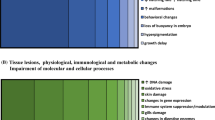Summary
Previously reported thresholds for UV-B dose and dose-rate were determined under artificial light regimes using more than an order of magnitude less visible light than found naturally. Near-UV and/or visible light is needed for photoreactivation, and the accuracy of earlier findings may have been influenced by less than maximum photorepair in the laboratory. Experiments with shrimp larvae and adult euphausiids, comparing survival at various UV-B doses and dose-rates combined with different levels of near-UV and visible irradiance, suggest that photorepair occurs in these organisms. Further, this apparent photorepair reaches maximum levels at relatively low visible light intensities.
Previously reported tolerance limits for shrimp larvae and adult euphausiids were confirmed (in particular, the relationship between dose/dose-rate safe and lethal limits in shrimp). Also, the earlier experimental design did not appear to have affected these limits since additional near-UV and visible light did not substantially alter the results.
In experiments using a 44-1 plastic cylinder (140-cm water depth), adult euphausiids successfully avoided moderate UV-B combined with visible light, but were attracted to and ultimately killed by higher levels of UV-B combined with low visible light. The apparent inability of euphausiids to directly detect harmful levels of UV-B irradiance would become an important factor in a new solar spectral distribution caused by ozone depletion.
Similar content being viewed by others
References
Caldwell MN, Nachtwey DS (1975) Introduction and overview. Impacts of climatic change on the biosphere. US Dep Transp, Clim Impact Assess Program (CIAP) Monogr 5, 1(1):3–30
Cook JS (1970) Photoreactivation in animal cells. Photophysiology 5:191–232
Cook JS, McGrath JR (1967) Photoreactivating-enzyme activity in Metazoa. Proc Nat Acad Sci 58:1359–1365
Damkaer DM, Dey DB (1982) Short-term responses of some planktonic Crustacea exposed to enhanced UV-B radiation. In: J. Calkins (ed.) The role of solar ultraviolet radiation in marine ecosystems; NATO Conf Ser 4 Mar Sci, Vol 7. Plenum Press New York-London pp 417–427, 470
Damkaer DM, Dey DB, Heron GA (1981) Dose/dose-rate responses of shrimp larvae to UV-B radiation. Oecologia (Berlin) 48:178–182
Damkaer DM, Dey DB, Heron GA, Prentice EF (1980) Effects of UV-B radiation on near-surface zooplankton of Puget Sound. Oecologia (Berlin) 44:149–158
Green AES, Miller JH (1975) Measures of biologically effective radiation in the 280–340 nm region. Impacts of climatic change on the biosphere. US Dep Transp, CIAP Monogr 5, 1(2):60–70
Jagger J (1967) Introduction to research in ultraviolet photobiology. Prentice-Hall, Englewood Cliffs, New Jersey 164 pp
Jokiel PL, York RH (1982) Solar ultraviolet photobiology of the reef coral Pocillopora damicornis and symbiotic zooxanthellae. Bull Mar Sci 32:301–315
Kaupp SE, Hunter JR (1981) Photorepair in larval anchovy, Engraulis mordax. Photochem Photobiol 33:253–256
Murphy TM (1975) Effects of UV radiation on nucleic acids. Impacts of climatic change on the biosphere. US Dep Transp, CIAP Monogr 5, 3(2):21–44
Nachtwey DS (1975) Potential effects on aquatic ecosystems of increased UV-B radiation. US Dep Transp, CIAP Conf Proc 4:79–86
NAS (1979) Protection against depletion of stratospheric ozone by chlorofluorocarbons. Nat Acad Sci, Washington, DC p 392
NRC (1982) Causes and effects of stratospheric ozone reduction: an update. Nat Res Council, Nat Acad Press, Washington, DC p 339
Rupert CS (1964) Photoreactivation of ultraviolet damage. Photophysiology 2:283–327
Rupert CS (1975) Enzymatic photoreactivation: overview. In: Hanawalt PC, Setlow RB (eds) Molecular mechanisms for repair of DNA Part A(11). Plenum Press New York pp 73–87
Setlow RB (1974) The wavelengths in sunlight effective in producting skin cancer: a theoretical analysis. Proc Nat Acad Sci 71:3363–3366
Siebeck O (1978) Ultraviolet tolerance of planktonic crustaceans. Verh Intern Verein Limnol 20:2469–2473
Sutherland BM (1975) The human leukocyte photoreactivating enzyme. In: Hanawalt PC, Setlow RB (eds) Molecular mechanisms for repair of DNA Part A (14). Plenum Press New York pp 107–113
Author information
Authors and Affiliations
Additional information
Contribution No. 1340 from the School of Oceanography, University of Washington, Seattle, WA 98195, USA
Rights and permissions
About this article
Cite this article
Damkaer, D.M., Dey, D.B. UV damage and photoreactivation potentials of larval shrimp, Pandalus platyceros, and adult euphausiids, Thysanoessa raschii . Oecologia 60, 169–175 (1983). https://doi.org/10.1007/BF00379518
Received:
Issue Date:
DOI: https://doi.org/10.1007/BF00379518




